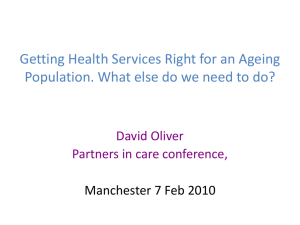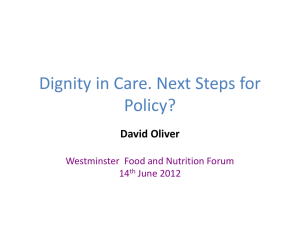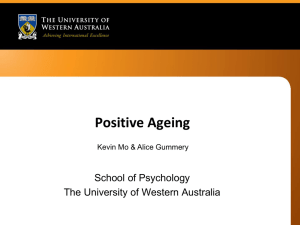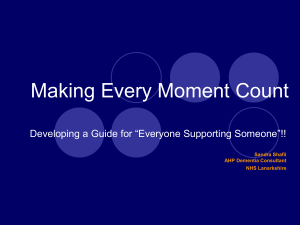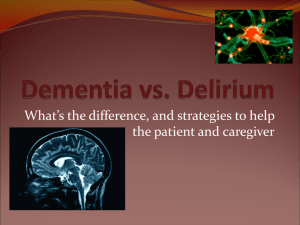Making services fit for an ageing population. What else
advertisement
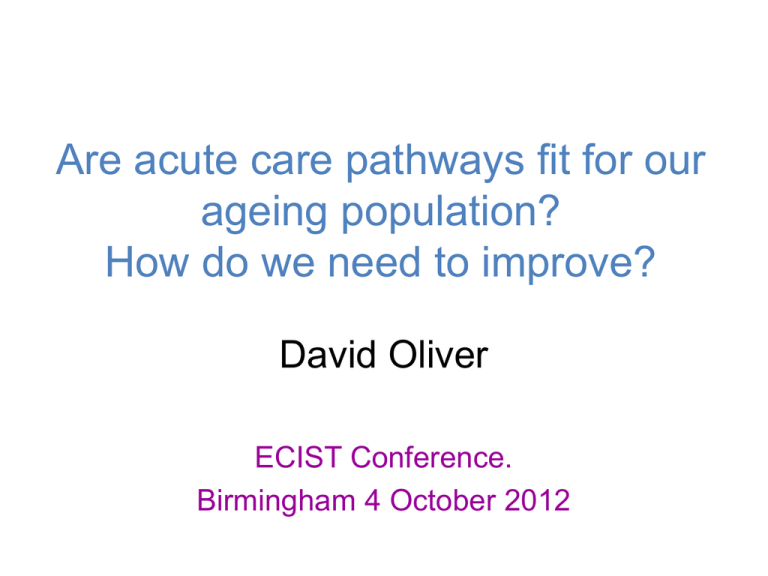
Are acute care pathways fit for our ageing population? How do we need to improve? David Oliver ECIST Conference. Birmingham 4 October 2012 To Cover • I: Why ageing, health and care for older people are in the news? “the perfect storm” • II: Population ageing in England • III: Implications for population health • IV: Implications for (hospital) services • “Older people R Us” • V: Quality in acute services for older people • VI: How could we get better? – a quick steer – A) Systems/ “end-to-end” pathways – B) Within hospitals I: Why ageing, health and care have a higher profile now than ever? 2012 – care for older people in England: A “perfect storm” • And a once-in-ageneration opportunity to effect lasting change 2012: “Perfect Storm” e.g. • • • • • • • • • • • • • Ombudsman “Care and Compassion” Patients’ Association C.A.R.E. campaign CQC DANI Inspections Age UK/NHS Confed. “Delivering Dignity” commission Dementia Strategy/PM Dementia Challenge Various reports on care for people with Dementia Social care funding/reform Age equality duty in Equality Act 26% cuts in local government support grant – impact on social care provision. £ 15-20bn “Nicholson Challenge” – Older patients with complex needs as key to delivery RCP “Hospitals on the Edge” report Francis Report…. Equality Act “our hospitals are struggling to cope with the challenges of an ageing population and rising hospital admissions” RCP 2012 (See also future hospitals commission) • “A fewer third general and acute hospital beds than 25 years ago but last decade has seen 37% increase in emergency admissions” • “Hospitals have coped by reducing length of stay but this fall has flattened and is now increasing for over 85s” • “2/3 of patients admitted to hospital are over 65 and many have dementia, frailty or complex needs….buildings, services and staff are not equipped to deal with them” II: Population Ageing in England Over the last 50 years, trend has moved from a ‘rectangularisation’ to an a ‘elongation’ (from “old” to “older”) Number over 80 has doubled in past two decades (See BMJ 2010 “oldest old double”) Around 18% of all deaths were before 65 in 2006 – the same proportion as in 1991 Distribution of death England 1841 - 2006 100% 90% 1981 1991 80% 1941 70% 2001 60% 50% 1841 2006 40% 30% 20% 10% 0% 1 5 9 13 17 21 25 Source: mortality.org, originally ONS 29 33 37 41 45 49 53 57 61 65 69 73 77 81 85 89 93 97 101 105 109 9 ONS Projections (146% increase in over 90s & 85% in over 80s in next 20 years) Services? Workforce? Pensions? Unpaid care? Inequalities persist Inequalities persist The success story of population ageing: A cause for celebration? • • • • • • • • • Better social conditions, housing, nutrition Better work-place safety Higher wealth Better child and maternal health Better public health Better preventative health interventions Better curative medical treatment Better management for long term conditions Better potential for individuals to flourish and have a long and active life III: What ageing really means for health and wellbeing: A balanced view. How older people define wellbeing.. Not just medical model of “absence of disease” • Control over daily life • Personal care and appearance • Food and drink • Accommodation (cleanliness and comfort) • Personal safety • Social participation • Occupation/activity • Dignity (in care) once you are acutely ill or dependent on care Wider Determinants: Potential for multiple disadvantages. Role of local government, benefits, housing etc? Proportion of older people more ill, dependent? e.g. • Health survey for England – 1 in 3 over 65 reported no longstanding illness – 60% over 65 reported no illness limiting lifestyle – 1 in 2 women over 80 reported no limiting illness • Census – 40% of 65 to 74 “good health”, 37% “fairly good” – Over 85, 60% F and 70% M “good or fairly good” • Cognitive function and ageing study (Brayne et al) • c. 1.3 M (15%) of people over 65 disabled, with 62% needing care at some point daily and 21% continuous care • So most older people are not disabled, dependent.. • Or in hospitals or nursing/residential homes But.....The result of increasing life expectancy on population prevalence of illness.. • People now either survive with one or more long-term conditions ( & multiple medications) • Live long enough to.. • ..develop conditions of ageing – e.g. dementia (800,000), osteoporosis, cataracts • Become frail • Develop functional, sensory, cognitive impairment • Become disabled or dependent to some degree • So reliant on formal or informal care or multiple services and contacts with multiple staff Multimorbidity in Scotland (Scottish School of Primary Care Barnett et al Lancet May 2012) – The majority of over-65s have 2 or more conditions, and the majority of over-75s have 3 or more conditions – More people have 2 or more conditions than only have 1 Most people with any long term condition have multiple conditions in Scotland (Scottish School of Primary Care) e.g. Only 18% with COPD just have COPD People with long-term conditions have high health service use (55% of all GP appointments, 68% of outpatient and A&E appointments and 77% of inpatient bed days and therefore 69% total health spend. People with limiting LTCs are the most intensive users of the most expensive services 100% % of services used 80% 60% 40% 20% 0% Number of people GP consultations Practice Nurse appointments Outpatient and A&E attendances Type of service 26 Source: 2005 General Household Survey. No LTC Non-limiting LTC 9 April, 2015 Limiting LTC Inpatient bed days Reported prevalence of disability clearly rises with age. We also need to understand how the severity of disability varies with age. Disability distribution over age 100% 90% Individuals without a disability, including limiting long standing illness 80% 70% 60% 50% 40% 30% Individuals with a disability, including limiting long standing illness 20% 10% 0% 0-15 27 16-24 25-34 35-44 45-54 55-59 Source: Family Resources Survey 2007 60-64 65-74 75-84 85+ Frailty – (only around 6% of over 65s but very high proportion of service use and predicts poor outcomes) [Weight loss, exhaustion, weakness, slow walking speed, diminished physical activity] (Fried Criteria)] ..”Frailty is a failure to integrate responses in the face of stress. This is why diseases manifest themselves as the “geriatric giants”….functions …such as staying upright, maintaining balance and walking are more likely to fail, resulting in falls, immobility, incontinence, delirium or general failure to thrive . A small insult can result in catastrophic loss of function” Rockwood Age Ageing 2004 i.e. Poor Functional Reserve IV: What this means for services Especially Hospital Inpatient Care People over 65 (England)... • 60% adult social care spend (£9bn) – 1.25 M out of 1.7 m users • 37% NHS Primary Care spend (£27bn) • 46% acute care spend (£ 27bn) • 12% NHS budget is on community health care (largely older people) (c £12bn) • [Average patient 81 and 43% over 85 in Intermediate Care Services] • Often those interdependent on multiple services [e.g. 60% of home care service users have been in hospital in previous year. 80% of delayed transfers are over 70) • Population ageing means this trend will continue Over 65s in hospital (England) (DH analysis of HES data) • • • • 60% admissions 70% bed days 85% delayed transfers 65% emergency readmissions • 75% deaths in hospital • 25% bed days are in over 85s High intensity users of hospital services have overlap of physical and social vulnerabilities Hospital Casemix • 1 in 4 adult beds occupied by someone with dementia (stay an average 7 days longer) • Delirium affects 1 in 4 patients over 65 • Urinary incontinence 1 in 4 over 65 • 1 in 4 over 65 have evidence of malnutrition • Falls and falls injuries account for more bed days than MI and Stroke Combined • Falls = 35% safety incidents (median age 82) • Most over admissions over 70 have some functional impairment and some need for MDT rehab (Hubbard 2005) • Hip fracture is a good example – Median Age 84, 12 month mortality 20-30%, 1 in 3 have dementia, 1 in 3 suffer delirium, 1 in 3 never return to former residence, 1 in 4 from care homes Older people in hospital • Majority of inpatients and bed days • The older you are the longer your stay • Emergency readmissions highest in over 75s and rising fastest • Older people more likely to be moved repeatedly during hospitalisation • Kings Fund 2011 Continuity of care for older people in hospital IV: Are services age-proof and fit for purpose? Are older people a “disadvantaged majority”? Lots of good services to celebrate and learn from and many satisfied patients and families so balance required... Prof Ken Rockwood 2005 “If we design services for people with one thing wrong at once but people with many things wrong turn up, the fault lies not with the users but with the service, yet all too often these patients are labelled as inappropriate and presented as a problem” Rt Hon Stephen Dorrell MP 2011 (HSJ) “Systems designed to treat occasional episodes of care for normally healthy people are being used to deliver care for people who have complex and long term conditions. The result is often that they are passed from silo to silo without the system having ability to co-ordinate different providers” What do we mean by “quality” in treatment and care? • Effectiveness. outcomes & adherence to good practice processes evidenced to deliver these • Safety • Experience of patients and carers • Efficiency. Ensuring value for money, costeffective treatment, minimising unwarranted variation/ensuring consistency, tackling inefficiencies at interfaces between agencies • (Fair/non-discriminatory) • (Joined-up/integrated/continuity) • Integration and discrimination are whole other talks Outcomes & adherence to evidencebased best practice • RCP national audits on falls and bone health x 4 (latest “falling standards, broken promises”, 2011) • National hip fracture database and Annual Reports • RCP national continence audit • RCPsych audit of dementia care in general hospitals • NHS Confederation “Acute Awareness” report on dementia • NCEPOD report on peri-operative care for people over 80 • “Age UK “still hungry to be heard” report • Work on anti-psychotic prescriptions in Dementia • Quest for Quality Report on health inputs in nursing and residential homes and Failing the Frail Audit • National audit of intermediate care • Consistent picture of gaps and variation in even most basic assessments and interventions Safety/adverse events e.g. • • • • • • • • • Falls (275,000 in English hospitals last year) Emergency readmissions/unsafe discharge Hospital mortality rates largely concern older people Drug errors (prescribing, administration, supervision) – (CHUMS study) Hospital acquired infections Pressure sores DVT Protection of vulnerable adults Delirium? Immobility? Dependence? Incontinence? Experience (patients, carers) e.g. • 2008 All parliamentary enquiry into older people in health and social care – “A disturbing picture, requiring an entire culture change” • NHS Ombudsman’s report “care and compassion” 2011 • Patients association report • Care Quality Commission Dignity and Nutrition Inspections 2011 • Various reports on dementia care in general hospitals 2010/11 • VOICES survey on end of life care 2012 • Francis Report on Mid-Staffs... • Common issues: Dignity, nutrition, communication, respect, information, continence, privacy, discharge from hospital, end of life care, pain relief, dementia care, attitudes “Many geriatricians think ageism is rife in NHS, poll suggests Nearly half blame institutional ageism for poor treatment of older patients” Guardian 2009 (BGS/Help the Aged Report) 2/3 geriatricians felt service institutionally ageist. 2/3 had witnessed ageist/discriminatory behaviour. “Right bed, wrong patients” “Seeing the person in the bed” Health Service Journal (2008) Sixty not out: managers' survey, Health Service Journal 118 (10 January 2008) : 28‐30. 1000 health service managers felt that older people and those with mental illness were the worse served Attitudes and behaviours “whose interests matter?” Arbitrary decisions made on age alone Older people denied investigation, diagnosis and treatment relative to younger people Services for conditions common in old age poorly prioritised Efficiency • Major unwarranted variations • e.g. hospital admission and length of stay for various groups and conditions • Care home placement • Delays, barriers etc at interfaces between agencies/care settings • We will not achieve the £15-20bn efficiency challenge without looking at older people inc. those with dementia and complex needs – Big spend, Big Variation, Poor integration, Double Running, Care Gaps etc National Hip Fracture Database From “An atlas of variations in social care” Audit commission value for money at health and social care interface 2011 From Kings Fund report 2012 on Emergency Bed use in Older People Audit commission value for money at health and social care interface 2011 From national audit of intermediate care 2012 Delayed transfers of care from acute hospitals. Number of Delayed Days during the month by reason 30,000 A) Awaiting completion of assessment B) Awaiting public funding 25,000 Total Delayed Days C) Awaiting further non-acute Dii) Awaiting nursing home placement or availability Di) Awaiting residential home placement or availability E) Awaiting care package in own home F) Awaiting community equipment and adaptations G) Patient or family choice 20,000 15,000 10,000 5,000 H) Disputes 0 Aug- Sep- Oct- Nov- Dec- Jan- Feb- Mar- Apr- M Jun- Jul- Aug- Sep- Oct- Nov- Dec- Jan- Feb- Mar10 10 10 10 10 11 11 11 11 ay- 11 11 11 11 11 11 11 12 12 12 11 Month I) Housing – patients not covered by NHS and Community Care Act V (a): How do we get better? An early steer.. (Solutions would be a whole other talk..) Across Systems and Pathways… Joined up commissioning and provision in localities. Utopia? Dystopia? Something in between? From King’s Fund Report “Older People and Emergency Bed Use” Focus For today A different approach? Continuity of Care Model a better conception (also requires right workforce, skills, capacity and resource in right part of system) Care in long term social care/supported housing setting or for those in receipt of social services Tertiary prevention Clinicians need to engage • • • • With pathway redesign Across organisational boundaries Stop “working in silos” Even if it means changing job plans and working practices • And get over the LTC vs Acute Care false dichotomy How do we get better? Within Hospital? Lots of guidance..e.g. The Silver Book My stuff..e.g. Benefits of CGA (Ellis and Langhorne) • 22 trials. 10,000 + participants, 6 countries • Patients more likely to be living at home at end of scheduled follow up (OR 1.16) • And at median follow up of 12 months (OR 1.25) • Compared to general medical care • Less likely to be living in residential/nursing care (OR 0.78) • Less likely to die or experience deterioration(OR 0.76) • More likely to experience improved cognition (Mean difference 0.08) • Specialist wards had better outcomes than teams for Apply the same principles within hospital Let’s “get with the programme” • Properly trained clinicians • With right skills and attitudes for the patients who actually come through the door • Early skilled senior assessment by MDT including skilled, interested, committed consultant • No more “acopia”/”social admission”/”bed blocker”/”right bed wrong patients”/”medically discharged” “inappropriate” etc etc • Functional problems have reversible diagnoses • Front door turnaround where appropriate • Assertive discharge planning from day one and every (7) day • Configuration of bed-base and numbers of specialists, supported by MDT professionals We have a once in a generation opportunity to transform care. Lets not waste it. • Thank You • David.Oliver@dh.gsi.gov.uk

